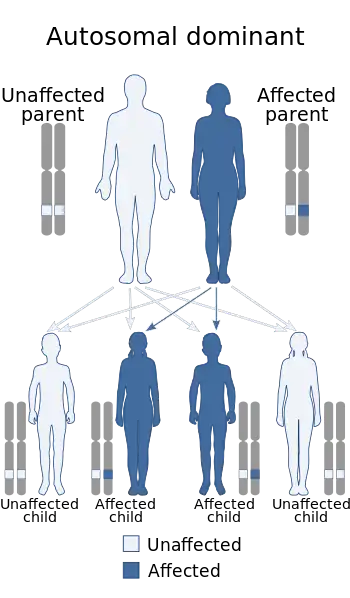Acrokeratoelastoidosis of Costa
| Acrokeratoelastoidosis of Costa | |
|---|---|
| Other names: Keratoelastoidosis marginalis[1] | |
.jpg.webp) | |
| Autosomal dominant is the inheritance manner for this condition | |
| Specialty | Dermatology |
Acrokeratoelastoidosis of Costa is an inherited skin condition characterized by multiple small horny bumps on the backs of the hands and feet, palms, soles, in which electron microscopy shows rarified, abnormal elastic tissue.[2]: 993 [3]: 214
Treatments such as liquid nitrogen, salicylic acid, tretinoin, and prednisone have been tried, though with limited success.[4]
It was characterized in 1953.[5]
Signs and symptoms
.jpg.webp) Keratoelastoidosis marginalis
Keratoelastoidosis marginalis.jpg.webp) Keratoelastoidosis marginalis
Keratoelastoidosis marginalis.jpg.webp) Keratoelastoidosis marginalis
Keratoelastoidosis marginalis
Genetics

See also
References
- ↑ Rapini, Ronald P.; Bolognia, Jean L.; Jorizzo, Joseph L. (2007). Dermatology: 2-Volume Set. St. Louis: Mosby. ISBN 978-1-4160-2999-1.
- ↑ Freedberg, et al. (2003). Fitzpatrick's Dermatology in General Medicine. (6th ed.). McGraw-Hill. ISBN 0-07-138076-0.
- ↑ James, William; Berger, Timothy; Elston, Dirk (2005). Andrews' Diseases of the Skin: Clinical Dermatology. (10th ed.). Saunders. ISBN 0-7216-2921-0.
- ↑ Zhai Z, Yang X, Hao F (2006). "Acrokeratoelastoidosis". Eur J Dermatol. 16 (2): 201–2. PMID 16613753. Archived from the original on 2021-08-27. Retrieved 2020-12-08.
- ↑ Costa OG (1953). "Akrokerato-elastoidosis; a hitherto undescribed skin disease". Dermatologica. 107 (3): 164–8. doi:10.1159/000256794. PMID 13116681.
External links
| Classification | |
|---|---|
| External resources |
This article is issued from Offline. The text is licensed under Creative Commons - Attribution - Sharealike. Additional terms may apply for the media files.